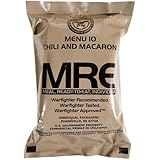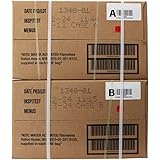Multifunctional Emergency Kits
What Are Multifunctional Emergency Kits?
Alright, let’s dive right in. Multifunctional emergency kits are essentially Swiss Army knives on steroids. They pack a multitude of lifesaving tools into a single, portable unit. I’ve found that these kits often include items like flashlights, multitools, blankets, and even water purification tablets.
Imagine being stranded during a blackout and knowing that everything you need is in one place. That’s the peace of mind multifunctional kits bring. You don’t have to fumble around in the dark trying to find a flashlight or figure out how to start a fire; it’s all there, ready to go.
While there are various models out there, the key is to find one that suits your specific needs. Whether it’s for hiking, camping, or just to keep in your car, a good multifunctional emergency kit can make all the difference.
Essential Components
The first thing I recommend is making sure your emergency kit includes a reliable means of light, like an LED flashlight. Trust me, you don’t want to rely on your phone’s flashlight when the battery is almost dead.
Next, think about multitools. A good multitool might have a knife, screwdriver, pliers, and even a can opener. It’s amazing how often these tools come in handy, especially when you least expect it.
Don’t forget about warmth and shelter. Portable blankets, ponchos, and compact shelters are crucial. They can make the difference between a miserable night and getting through it safe and sound.
Convenient Ways to Carry Them
One of the beauties of these kits is their portability. Most are designed to be lightweight and easy to carry. Some can fit right into a backpack, while others have convenient carry straps or even can be attached to your belt.
I always look for kits that are waterproof. The last thing you want is your gear getting soaked, rendering it useless. It’s a small detail, but it can make a huge difference.
== > What if ... Get a FREE Subscription to PREPARE
Finally, consider how easy the kit is to access. Can you get to all the tools without having to unpack everything? Accessibility is crucial in an emergency. Quick and easy access to your tools can save valuable time.
Communication Devices
The Importance of Staying Connected
If there’s one thing I’ve learned, it’s that staying connected is a lifeline in an emergency. Communication devices are essential tools for emergency preparedness. They ensure you can reach out for help or keep in touch with loved ones when it matters most.
In our tech-driven world, we often rely on our smartphones. But what happens when the battery dies or there’s no service? Since then, I’ve always stressed the importance of having back-up communication devices.
Think about it: without a way to communicate, you’re practically stranded. That’s why having a variety of communication options is a game changer.
Types of Communication Devices
First up, walkie-talkies or two-way radios are fantastic. They let you communicate with others nearby, and they don’t rely on cell towers. Great for hiking trips or even just for keeping in the house.
Satellite phones are another incredible option. Unlike cellphones, satellite phones connect directly to satellites, ensuring you’ve got signal no matter where you are. They’re pricier, sure, but sometimes peace of mind is worth it.
Finally, consider a hand-crank radio. Yes, a bit old school, but these radios often come with built-in chargers for your phone and can receive emergency broadcasts. I’ve always got one in my emergency kit, just in case.
Maintaining Your Devices
It’s one thing to have these devices, but maintaining them is equally important. Always keep extra batteries or ensure your devices are regularly charged. You don’t want to find out your walkie-talkie is dead when you need it the most.
For satellite phones, regularly check for software updates and ensure your subscription or service plan is up to date. A lapse in service can mean the difference between help and helplessness.
Store your devices in a dry, safe place to prevent damage. Water and electronics don’t mix well, trust me. Keep them easily accessible but protected.
First Aid Supplies
Why First Aid Supplies Are Non-Negotiable
You never really understand the importance of first aid supplies until you need them. Trust me, having a well-stocked first aid kit can be a literal lifesaver. Whether it’s a minor cut or something more serious, being prepared can make all the difference.
Imagine you’re out hiking and someone twists their ankle, or a simple cooking mishap turns into a bleeding cut. In these moments, quick access to first aid supplies can save the day.
I’ve always emphasized the importance of not just having a first aid kit but also knowing how to use it. It’s one thing to have the supplies; it’s another to use them effectively.
Essential Items to Include
First things first, make sure you have bandages in various sizes. From small cuts to larger wounds, you’ll need different types and sizes. Adhesive bandages, gauze pads, and medical tape are must-haves.
Antiseptics, like alcohol wipes or hydrogen peroxide, are crucial for cleaning wounds. Infection can turn a minor injury into a serious problem, so it’s important to have the right supplies to keep wounds clean.
Don’t forget about over-the-counter medications like pain relievers, antihistamines, and burn ointments. They can provide instant relief and make a world of difference in an emergency.
Storing and Accessing Your Supplies
Organize your first aid supplies in a way that makes them easy to find. The last thing you want in an emergency is to be digging through your kit, trying to find the right item. Labeling compartments can help a lot.
Keep your first aid kit in a cool, dry place. Moisture can ruin bandages and other supplies, so proper storage is key. I’ve found that waterproof containers are great for this purpose.
Regularly check your supplies to ensure nothing is expired. Medications and certain antiseptics have a shelf life. Make it a habit to replace used or expired items promptly to keep your kit fully functional.
Food and Water Storage Solutions
The Basics of Food and Water Storage
When it comes to emergency preparedness, food and water are top priorities. You can’t survive without them, and having a reliable stash can make all the difference. I’ve always prioritized creating a stockpile of essentials for any emergency situation.
Water is obviously number one. Each person needs about a gallon of water per day, for drinking and sanitation. Having enough water for every household member is crucial. I always recommend having at least a three-day supply, if not more.
Food storage is equally important. Focus on non-perishable items like canned goods, dried fruits, nuts, and grains. They have a long shelf life, and can provide essential nutrients when fresh food is not available.
Effective Storage Tips
One of the best tips I can share is to rotate your stock. Use the oldest items first and replace them with new ones. This practice ensures your food stays fresh and decreases waste.
Store food in airtight, waterproof containers. Trust me, you don’t want to find out your emergency food has been compromised by pests or moisture. Containers designed for long-term storage are your best bet.
Place your food and water supplies in a cool, dark place. Both heat and light can accelerate the spoilage of food. A basement or a dedicated pantry is ideal for this purpose.
Meal Planning for Emergencies
Planning meals ahead of time can make it easier to manage your food supply during an emergency. Think about balanced meals that can be easily prepared with minimal resources. You want to ensure you’re getting essential nutrients.
Canned meats, beans, and vegetables can be combined in various ways to create simple, nutritious meals. Having a manual can opener is a must. I’ve been caught without one before, and it’s no fun.
Don’t forget about comfort foods. In a stressful situation, having a few treats can boost morale. Chocolate, instant coffee, or even some shelf-stable cookies can go a long way in keeping spirits high.
FAQ
1. What should be the first priority in emergency preparedness?
The first priority should always be safety. Ensuring you have the basic necessities like water, food, first aid, and communication tools is essential for survival.
2. How often should I update my emergency kit?
You should check and update your emergency kit every six months. Replace any expired items and reassess your needs based on seasonal changes or new family members.
3. What’s the best way to store emergency water?
Store emergency water in clean, airtight containers in a cool, dark place. You can also use commercially bottled water, which has an extended shelf life. Rotate and replace your water supply every six months.
4. How can I ensure my first aid supplies are effective?
Regularly check your first aid supplies for expiration dates and replace any used or outdated items. Make sure you know how to use each item effectively by reading instructions or taking a basic first aid course.
Related Content
Military MRE Single Meal Inspection Date May 2025 or Newer(Chili & Macaroni)
$19.50 (as of December 25, 2025 18:19 GMT -05:00 - More infoProduct prices and availability are accurate as of the date/time indicated and are subject to change. Any price and availability information displayed on [relevant Amazon Site(s), as applicable] at the time of purchase will apply to the purchase of this product.)Wornick Sopacko, Ameriqual MRE Meals Ready to Eat Inspection 2025, 2026 or Better, Emergency Food Supply, Survival Camping Outdoor 12 Pack(A & B Case Bundle, 2, Count)
Now retrieving the price.
(as of December 25, 2025 18:19 GMT -05:00 - More infoProduct prices and availability are accurate as of the date/time indicated and are subject to change. Any price and availability information displayed on [relevant Amazon Site(s), as applicable] at the time of purchase will apply to the purchase of this product.)





